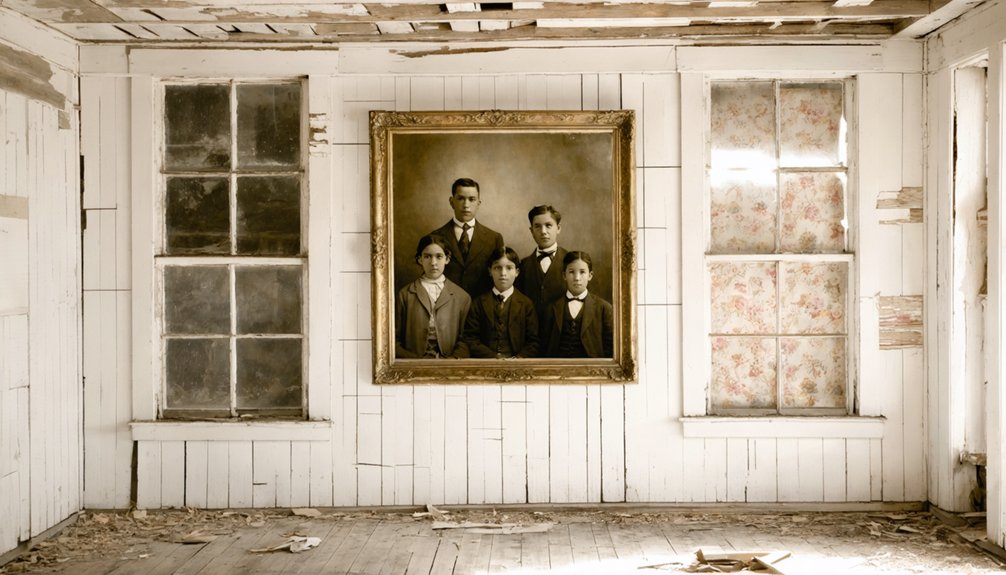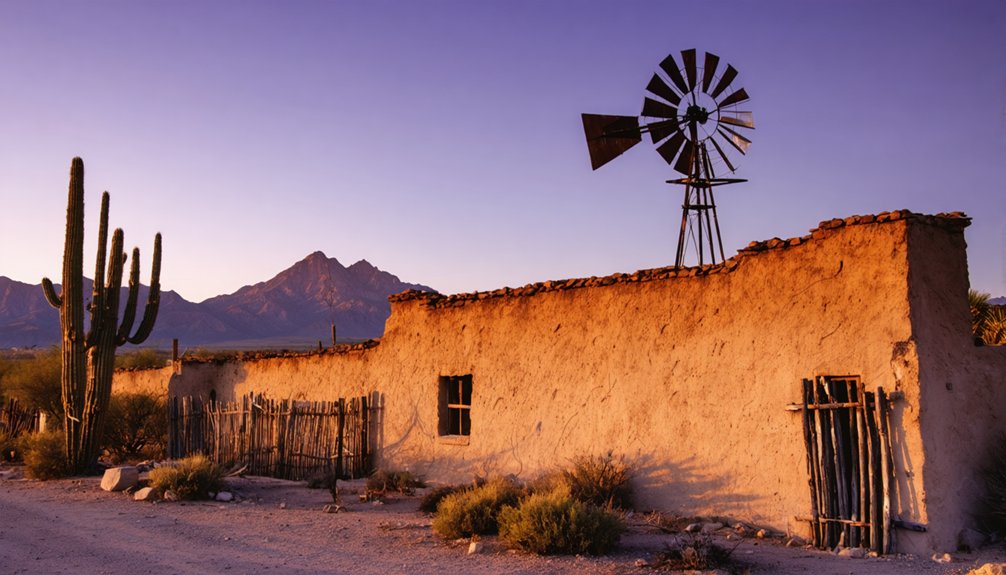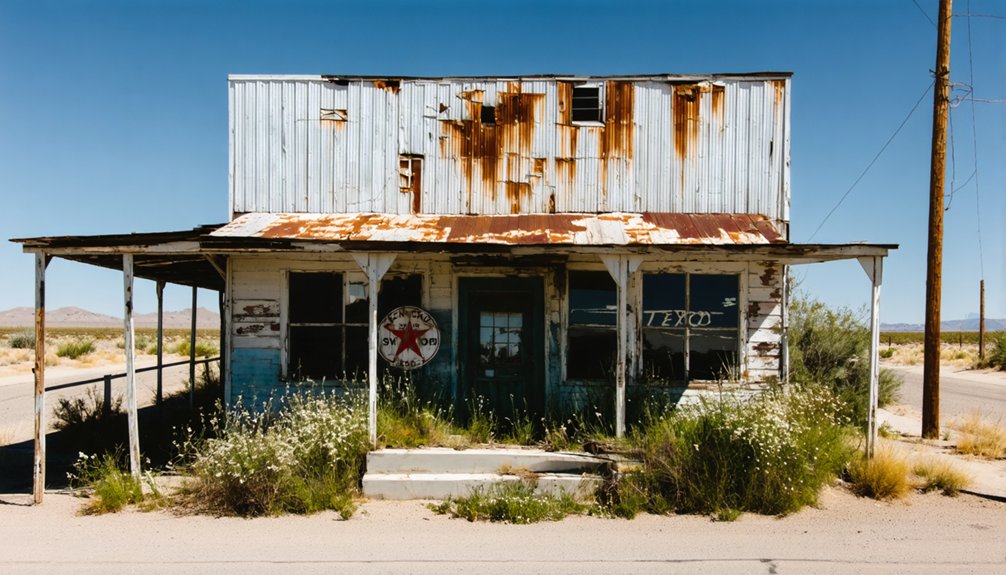You’ll find Las Islas among Texas’s most fascinating ghost towns, where mercury and coal mining once sustained 300 residents in the early 1900s. The Chisos Mining Company controlled daily life through company housing, stores, and wages while immigrant workers from Poland, Italy, and Britain brought valuable skills to the frontier settlement. Railroad expansion fueled unprecedented growth until the 1930s when resource depletion began the town’s decline. Today’s crumbling foundations and abandoned tunnels tell stories of boom-and-bust desert economics.
Key Takeaways
- Former mining settlement that flourished in late 19th century Texas, primarily focused on mercury and coal extraction.
- Operated as a company town under Chisos Mining Company, which controlled housing, commerce, and social life.
- Population peaked at 300 residents during mining operations but declined sharply when resources depleted in late 1930s.
- Significant railroad junction connecting north-south and east-west routes, contributing to regional economic growth until the 1920s.
- Now stands as a ghost town with abandoned structures, illustrating the boom-and-bust cycle of resource-dependent desert communities.
The Rise of a Mining Frontier
While Spanish and Mexican miners had long worked the mineral-rich regions near Texas, Las Islas emerged as a significant frontier mining settlement during the late 19th century.
You’ll find evidence of their early mining techniques in the underground galleries and shafts, where cut nails, pickpoints, and drill marks still tell the story of mineral extraction. The mining claims attracted notable figures like Don Felix Gibert and Mexican Consul Plutarco Ornelas, who helped bridge Mexican and Texan interests in the region.
As you explore the remnants, you’ll discover how miners tackled frontier challenges through complex tunnel systems and cable-hauling infrastructure. Much like the gallery-style systems of the Jesuits, these mines showcased sophisticated engineering for their time. Prospectors discovered three distinct archeological mine sites that revealed the evolution of mining practices in the area.
They built smelters and processing facilities using local materials like limestone and adobe, while adapting to harsh desert conditions and limited water supplies that shaped their daily operations.
Life in a Company Town
As the mining operations expanded in Las Islas, the town transformed into a quintessential company-controlled settlement where you’d find every aspect of daily life tied to the primary industrial employer.
You’d live in company housing, shop at the company store, and work according to the company’s production schedules. Your wages would be subject to automatic deductions for rent and store credit.
Much like the early Villa de Bexar settlement, the town served as housing for workers and their families. Similar to how the Mission and Presidio communities maintained distinct identities while cooperating, the company divisions created clear social hierarchies. Company control extended deep into communal life, with management overseeing everything from social gatherings to education.
While you’d experience a close-knit community through company-sponsored events and shared facilities, you’d also face strict oversight of your activities.
Better positions meant better housing and privileges, but for most workers, life meant limited autonomy and economic freedom.
Any dispute with management would be handled internally, leaving you with few options for external recourse.
Railroad’s Golden Era
You’ll find that Las Islas experienced its most vibrant period during the early 1900s railroad expansion, when the town served as a vital junction for north-south and east-west rail traffic.
The town’s strategic location along the newly constructed lines made it an important stop for both freight and passenger service, connecting rural communities to larger market centers. Both the Rock Island Railway and the Atchison, Topeka & Santa Fe Railway brought increased commerce and transportation options to the region. Today, railroad enthusiasts can explore similar historic sites at Texas Transportation Museum on Wetmore Road.
Like many Texas towns of that era, Las Islas flourished as railroad crews laid track and established maintenance facilities, bringing economic opportunities and new residents to the region.
Railroad Construction Impact
During the railroad’s golden era, Las Islas emerged as one of many strategic stops along Texas’s expanding rail network, particularly after the Rio Grande and Pecos Valley Railroad established operations in the region during 1882.
The railroad expansion transformed this once-empty stretch of land into a bustling community development hub, marking a significant shift in the area’s economic potential. Similar to Comstock’s peak years, Las Islas experienced significant population growth between 1888 and 1910. The area gained notoriety after reports of ghost train whistles disturbed passengers between nearby towns.
- The establishment of a rail stop attracted ranchers who needed reliable shipping points for their cattle.
- Coal shipping operations flourished, making Las Islas a crucial fuel center for steam locomotives.
- Local commerce grew around the railroad, including essential services for train operations.
- The town’s strategic location along the rail line fostered integration into broader regional trade networks.
Like many railroad towns of its era, Las Islas’s growth directly reflected the transformative power of rail infrastructure in shaping Texas’s frontier communities.
Peak Transportation Years
The golden age of rail transport brought three decades of unprecedented growth to Las Islas between 1890-1920.
You’d have witnessed Southern Pacific’s aggressive railroad expansion through South Texas during this era, connecting the region to major market centers like San Antonio and Houston. Texas reached 17,078 miles of track by 1932, demonstrating the incredible scale of rail development across the state. The railway’s infrastructure development transformed Las Islas into a bustling transit point for both freight and passenger services.
As you explored the town during these peak years, you’d have seen the impact of modernized passenger services, with streamlined routes offering regular connections to coastal ports and inland destinations. Today, you can visit the Texas Transportation Museum on Wetmore Road to see preserved artifacts from this era.
The railroad’s presence sparked real estate development and elevated land values, while agricultural products and cattle from surrounding ranches moved efficiently through Las Islas’s rail yards to reach broader markets across Texas and beyond.
Economic Peak and Daily Operations
While mercury and coal mining formed the economic backbone of Las Islas, this Texas company town reached its zenith between 1900-1914 with 300 residents at its peak. The town’s economic sustainability relied heavily on the mining infrastructure established by the Chisos Mining Company, which controlled most aspects of daily life.
Las Islas exemplified the classic company town model, where the Chisos Mining Company’s mercury operations shaped every facet of community life.
- The W.W. Cole Building housed essential services like the bank and pharmacy.
- A company store provided supplies while the general store served daily needs.
- Multiple mining shafts operated simultaneously during peak production years.
- The Rio Grande and Pecos Valley Railroad facilitated mineral shipments.
You’d find a complete company town setup, with worker housing, a church, and support services all managed by the mining company.
This vertically integrated structure kept the town running efficiently until resource depletion began in the late 1930s.
The Faces Behind Las Islas

You’ll find the compelling stories of Las Islas’ mining families reflected in the diverse backgrounds of its immigrant workers, who came from Poland, Italy, Britain, and Ireland to apply their valuable mining skills.
These hardy settlers established themselves in simple stacked-rock homes while working for the Chisos Mining Company, forming tight-knit ethnic communities that preserved their cultural traditions.
The town’s cemeteries and surviving structures, including a Polish craftsman’s 1908 smokestack, stand as evidence to the rich multicultural legacy of these pioneering families.
Mining Family Stories
Deep within the historical records of Las Islas, Texas, family stories of mining and land rights interweave through generations, particularly centered on the prominent Ballí family legacy.
Through extensive research culminating in 1985, original deeds validated oral histories and strengthened resource disputes that continue to shape the region’s narrative.
- The Ballí family’s retained mineral rights from their 1938 land sale sparked decades of legal battles.
- Oil drilling in the 1950s transformed traditional ranching lands into industrial extraction sites.
- Sixteen Canary Islander families established the governance framework that would impact future mining rights.
- Descendants of noble-titled settlers maintained influence over local resource control.
You’ll find these family legacies etched not just in documents but in the very landscape of Las Islas, where oil rigs now stand as monuments to generational perseverance.
Immigrant Worker Culture
These settlers transformed the frontier through their labor, establishing successful farms and ranches that often rivaled nearby mission operations.
While their official status as nobility set them apart, they weren’t afraid to work the land themselves.
They built bridges between Spanish authorities and indigenous peoples, creating a unique cultural blend through intermarriage and trade.
Their community ceremonies and festivities kept their heritage alive, even as they adapted to life on the Texas frontier.
Signs of Decline
Several unmistakable signs marked Las Islas’s transformation from a thriving community into a ghost town, mirroring the fate of other Texas settlements like Best and Belle Plain.
Like countless frontier settlements before it, Las Islas faded from bustling town to empty streets, joining Texas’s growing constellation of ghost towns.
You’ll recognize the familiar pattern of decline through these key indicators:
- Sharp population decline as younger residents fled to urban areas, leaving only a handful of aging inhabitants behind
- Infrastructure decay visible in the abandoned storefronts, collapsed roofs, and crumbling foundations of once-vital businesses
- Closure of essential services including the post office and general store, cutting off the community’s lifeline
- Diminished law enforcement presence leading to increased vulnerability and further exodus of remaining families
Like many Texas ghost towns before it, Las Islas’s isolation from major transportation routes accelerated its downward spiral, ultimately sealing its fate as another lost settlement of the region.
Legacy in the Desert

Despite its abandonment, Las Islas left an indelible mark on Texas’s industrial heritage through its role in early 20th-century mining and railroad development.
Today, you’ll find scattered remnants of its once-thriving community among the desert landscape, where weathered buildings and cultural artifacts tell stories of boom-and-bust economics.
The town’s legacy extends beyond its physical remains.
You’re witnessing a snapshot of Texas’s industrial evolution when you explore Las Islas, as it exemplifies the transient nature of resource-dependent settlements in the arid Southwest.
While desert preservation efforts remain limited, historians and archaeologists continue studying the site’s significance.
The ghost town serves as an open-air classroom, teaching valuable lessons about the relationships between resources, transportation, and community survival in early Texas development.
Exploring the Remnants Today
When visiting Las Islas today, you’ll find a sparse collection of deteriorating structures scattered across the southwestern Webb County desert landscape.
Located near coordinates 27.66722°N, 99.65306°W, you’ll need to navigate unpaved roads to reach this remote site where abandoned structures slowly surrender to desert overgrowth.
- Track down faint traces of the old railroad bed and coal shipping facilities that once made this town thrive
- Explore deteriorated building foundations and partial walls, now serving as silent witnesses to the site’s mining past
- Look for scattered remnants of early 1900s infrastructure, mostly hidden beneath native vegetation
- Document your findings through photography, as no formal preservation efforts protect these ruins
Access may require landowner permission, as the site lies on private property typical of South Texas ghost towns.
Frequently Asked Questions
Are There Any Reported Ghost Stories or Paranormal Activities in Las Islas?
You won’t find documented ghost sightings or paranormal encounters in historical records about this location – available research shows no verified supernatural activity, though many Texas ghost towns have similar legends.
What Happened to the Mining Equipment After the Town Was Abandoned?
You’d find most mining equipment was sold and hauled away during the 1940s-50s. What wasn’t sold deteriorated in the harsh desert climate or was scrapped for parts by salvage operations.
Can Visitors Legally Explore the Las Islas Ghost Town Today?
You can’t legally explore Las Islas without landowner permission since it’s on private property. Ghost town regulations require explicit consent, and visitor safety concerns make unauthorized access both dangerous and unlawful.
Were There Any Major Accidents or Disasters in Las Islas Mines?
Like fading footprints in desert sand, no major mining accidents or disasters have been documented at these mines. Historical disaster reports from Texas don’t mention any significant incidents here.
What Natural Wildlife Now Inhabits the Abandoned Town Site?
You’ll find diverse wildlife species thriving there now – coyotes prowl the ruins, bobcats hunt at night, while hawks nest in old structures. The abandoned site’s ecological impact created perfect habitat for lizards and deer.
References
- https://www.youtube.com/watch?v=xfkTFb3Izpk
- https://www.hipcamp.com/journal/camping/texas-ghost-towns/
- https://texashighways.com/travel-news/four-texas-ghost-towns/
- https://www.southernthing.com/ruins-in-texas-2640914879.html
- https://www.youtube.com/watch?v=Jkdn0Q6IS0c
- https://en.wikipedia.org/wiki/Islitas
- https://www.atlasobscura.com/places/lajitas-ghost-town
- https://en.wikipedia.org/wiki/List_of_ghost_towns_in_Texas
- https://www.ranchocacachilas.com/mining-history
- https://www.texasbeyondhistory.net/plateaus/images/he13.html



